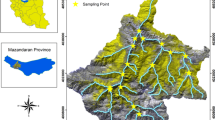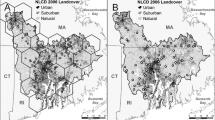Abstract
Several studies relating land cover to stream properties have used sample sizes of more than 100 watersheds, but the variance that they explain is moderate to low (R 2 less than 50%), limiting the predictive value of these studies when their models are applied to watersheds that were not included in the models’ development. We hypothesize that this is due to the increases in variation that occur with increases in sample size and in the geographic scales of the areas in which the watersheds are distributed. Land cover alone cannot explain all of that variation; more predictors must be considered. Conversely, models with high explicative power would require relatively small sample sizes distributed over small areas. This hypothesis was evaluated sampling 17 watersheds from southern Chile’s Lake Region, for which we developed regressive models between land cover/watershed area/precipitation/geomorphology and stream properties (i.e., conductivity, temperature). With a maximum n = 15 watersheds, on a regional scale, a poorly explained variation in hydrologic variables (mean 37–49%) was obtained. The R 2 increased slightly, to 45–52%, when precipitation was included as a predictor. In half of the cases analyzed, the models improved when geomorphology was considered as an additional predictor (60–66%), supporting our hypothesis. Furthermore, when our analysis was restricted to a narrower latitudinal span (n = 9), the R 2 was much stronger (68–87%) when only land cover and watershed area were included as predictors. These percentages also increased when more predictors were incorporated. Nevertheless, a portion of unexplained variance remained that would require the consideration of more predictors, such as geology and edaphology. The documented trade-off provides evidence that argues against the spatial generality of land cover/stream property models.
Similar content being viewed by others
References
Allan JD, Johnson LB (1997) Catchment-scale analysis of aquatic ecosystems. Freshwater Biol 37:107–111
Armesto JJ, Rozzi R, Smith-Ramírez C, Arroyo MTK (1998) Conservation targets in South American temperate forests. Science 282:1271–1272
Biggs TW, Dunne T, Martinelli LA (2004) Natural controls and human impacts on stream nutrient concentrations in a deforested region of the Brazilian Amazon basin. Biogeochemistry 68:227–257
Brady N, Weil R (2000) Elements of the nature and properties of soil. Prentice Hall, New Jersey, USA
Caraco NF, Cole JJ, Likens GE, Lovett GM, Weathers KC (2003) Variation in NO3 export from flowing waters of vastly different sizes: does one model fit all? Ecosystems 6:344–352
Creed IF, Band LE (1998) Export of nitrogen from catchments within a temperate forest: evidence for a unifying mechanism regulated by a variable source area dynamics. Water Resour Res 34:3105–3120
di Castri F, Hajek ER (1976) Bioclimatología de Chile. Vicerrectoría Académica de la Universidad Católica de Chile, Santiago, Chile
Dillon PJ, Molot LA (1992) The role of ammonium and nitrate retention in the acidification of lakes and forested catchments. Biogeochemistry 11:23–43
Dinerstein E, Olson D, Graham D, Webster A, Primm S, Bookbinder M, Ledec G (1995) A conservation assessment of the terrestrial ecoregions of Latin America and the Caribbean. WWF –World Bank, Washington, USA
Donoso C (1993) Bosques templados de Chile y Argentina. Variación, Estructura y Dinámica. Ecología Forestal. Editorial Universitaria, Santiago, Chile
Donoso C, Lara A (1995) Utilización de los bosques nativos en Chile: pasado, presente y futuro. In: Armesto JJ, Villagrán C, Arroyo MK (eds) Ecología de los bosques nativos de Chile. Editorial Universitaria, Santiago, Chile, pp 363–387
Echeverría C, Lara A (2004) Growth patterns of secondary Nothofagus obliqua- N. alpina forests in southern Chile. Forest Ecol Manage 195:29–43
Graham LP (1999) Modeling runoff to the Baltic Sea. Ambio 28:328–334
Hedin LO, Armesto JJ, Johnson AH (1995) Patterns of nutrient loss from unpolluted old-growth temperate forests: evaluation of biogeochemical theory. Ecology 76:493–509
Herlihy AT, Stoddard JL, Johnson CB (1998) The relationships between stream chemistry and watershed land cover data in the mid-Atlantic region, U.S. Water Air Soil Pollut 105:377–386
Heusser C (1974) Vegetation and climate of the southern Chilean Lake District during and since the last interglaciation. Quaternary Res 4:290–315
Iroumé A (2003) Transporte de sedimentos en una cuenca de montaña en la Cordillera de los Andes de la Novena Región de Chile. Bosque 24:125–135
Johnson LB, Richards C, Host GE, Arthur JW (1997) Landscape influences on water chemistry in midwestern stream ecosystems. Freshwater Biol 37:193–208
Lara A, Veblen TT (1993) Forest plantations in Chile: a successful model? In: Marther A (ed) Afforestation policies, planning and progress. Behalven Press, London, UK, pp 118–139
Lara A, Sandoval V (2003) Generación de cartografía y evaluación de recursos vegetacionales. In: Oltremari J, Thelen KD (eds) Planificación de áreas silvestres protegidas. Un manual para la planificación de áreas protegidas en Chile con especial referencia a áreas protegidas privadas. CONAMA & FAO, Santiago, Chile, pp 48–63
Lara A, Donoso C, Aravena JC (1995) La conservación del bosque nativo en Chile: problemas y desafíos. In: Armesto JJ, Villagrán C, Arroyo MK (eds) Ecología de los bosques nativos de Chile. Editorial Universitaria, Santiago, Chile, pp 335–362
Lara A, Soto D, Armesto J, Donoso P, Wernli C, Nahuelhual L, Squeo F (eds) (2003) Componentes científicos clave para una política nacional sobre usos, servicios y conservación de los bosques nativos chilenos. Iniciativa Científica Milenio de Mideplan, Universidad Austral de Chile, Valdivia, Chile
Le Roux JP, Elgueta S (2000) Sedimentologic development of a Late Oligocene–Miocene forearc embayment, Valdivia Basin Complex, southern Chile. Sediment Geol 130:27–44
Little C (2005) Exportación de nitrógeno desde la cuenca de Río Valdivia, Chile. Forestry Engineering M.S. Thesis, Universidad Austral de Chile, Valdivia, Chile
Martínez R, Pino M (1979) Edad, paleoecología y sedimentología del Mioceno Marino de la cuesta Santo Domingo, Prov. de Valdivia. In: Proceedings II␣Congreso Geológico Chileno, Arica, Chile. Instituto␣de Investigaciones Geológicas, Tomo 3, pp␣103–124
Mella A, Kühne A (1985) Sistemática y descripción de las familias, asociaciones y series de suelos derivados de materiales piroclásticos de la zona central-sur de Chile. In: Tosso J (ed) Suelos volcánicos de Chile. INIA, Santiago, Chile, pp 549–716
Moore RB, Johnston CM, Robinson KW, Deacon JR (2004) Estimation of total nitrogen and phosphorus in New England streams using spatially referenced regression models. Scientific Investigations Report 2004–5012. U.S. Department of the Interior, U.S. Geological Survey, Pembroke, New Hampshire, USA
Otero L, Contreras A, Barrales L (1994) Efectos ambientales del reemplazo de bosque nativo por plantaciones (Estudio en cuatro microcuencas en la provincia de Valdivia). Ciencia e Investigación Forestal 8:252–276
Oyarzún CE, Huber A (2003) Nitrogen export from forested and agricultural watersheds of southern Chile. Gayana Bot 60:63–68
Peña H (1999) Dirección General de Aguas 1969–1999, 30 años. Editorial Ponce de León y Escobar, Santiago, Chile
Pérez CA, Hedin LO, Armesto JJ (1998) Nitrogen mineralization in two unpolluted old-growth forests of contrasting biodiversity and dynamics. Ecosystems 1:361–373
Pezoa L (2003) Recopilación y análisis de la variación de las temperaturas (período 1965–2001) y las precipitaciones (período 1931–2001) a partir de la información de estaciones meteorológicas de Chile entre los 33° y 53° de latitud Sur. Forestry Engineering Thesis, Universidad Austral de Chile, Valdivia, Chile
Putuhena W, Cordery I (2000) Some hydrological effects of changing forest cover from eucalyptus to Pinus radiata. Agric For Meteorol 100:59–72
Quinn P, Beven KJ, Lamb R (1995) The ln(a/tanβ) index: how to calculate it and how to use it within the TOPMODEL framework. Hydrological Processes 9:161–182
SERNAGEOMIN (Servicio Nacional de Geología y Minería) (ed). (1998) Estudio Geológico-Económico de la X Región Norte. Geología Económica, Recursos minerales y energéticos. Informe Registrado IR-98–15. Servicio Nacional de Geología y Minería, Subdirección Nacional de Geología, Santiago, Chile
Sokal RR, Rohlf FJ (1995) Biometry. 3rd edn. WH Freeman & Company, New York, USA
Soto D, Lara A (2001) Valoración alternativa de los bosques nativos como proveedores de servicios ecosistémicos a los ambientes acuáticos. In: Primack R, Rozzi R, Feinsinger P, Dirzo R, Massardo F (eds) Elementos de Conservación Biológica: Perspectivas Latinoamericanas. Fondo de Cultura Económica, Ciudad de México, México, pp 295–297
Stockner JG, MacIsaac EA (1996) British Columbia lake enrichment programme: two decades of habitat enhancement for sockeye salmon. Regul Rivers Res Manage 12:547–561
Stockner JG, Shortreed KRS (1978) Enhancement of autotrophic production by nutrient addition in a coastal rainforest stream on Vancouver Island. J Fish Res Board Can 35:28–34
Strayer DL, Beighley RE, Thompson LC, Brooks S, Nilsson C, Pinay G, Naiman RJ (2003) Effects of land cover on stream ecosystems: roles of empirical models and scaling issues. Ecosystems 6:407–423
Thomas SM, Neill C, Deegan LA, Krusche AV, Ballester VM, Victoria RL (2004) Influences of land cover and stream size on particulate and dissolved materials in a small Amazonian stream network. Biogeochemistry 68:135–151
Universidad Austral de Chile, Pontificia Universidad Católica de Chile, Universidad Católica de Temuco, Geotécnica Consultores (1995) Catastro y evaluación de recursos vegetacionales nativos de Chile. Manual de Cartografía de la Vegetación. Valdivia, Chile
Veblen TT, Kitzberger T, Burns BR, Rebertus AJ (1995) Perturbaciones y dinámica de regeneración en bosques andinos del sur de Chile y Argentina. In: Armesto JJ, Villagrán C, Arroyo MK (eds) Ecología de los bosques nativos de Chile. Editorial Universitaria, Santiago, Chile, pp 169–198
Vitousek PM, Aber JD, Howarth RW, Likens GE, Matson PA, Schindler DW, Schlesinger WH, Tilman DG (1997) Human alteration of the global nitrogen cycle: causes and consequences. Issues Ecol 1:1–15
Wetzel RG, Likens GE (1979) Limnological analysis. W.B.␣Saunders Company, Philadelphia, U.S.A
Yang X, Chapman GA, Young MA, Gray JM (2005). Using compound topographic index to delineate soil landscape facets from digital elevation models for comprehensive coastal assessment. In: Zerger A, Argent RM (eds) MODSIM 2005 International Congress on Modelling and Simulation. Modelling and Simulation Society of Australia and New Zealand, December 2005, ISBN: 0-9758400-2-9, pp␣1511–1517. http://www.mssanz.org.au/modsim05/papers/yang_x.pdf
Zahradnik P (1981) Methods for chemical analysis of inland waters. Lecture notes for the International Graduate Training Course on Limnology. Limnologishes Institut, Österreichische Akademie der Wissenschaten, Viena, Austria
Acknowledgments
We would like to thank Christian Little, for pertinent discussions, and Marcelo Navarrete, Liliana Pezoa, Eduardo Neira, Patricio Rutherford, and Rocío Urrutia, for providing data for earlier drafts of this paper. All of the other members of Forecos are also acknowledged for their commentaries, which have improved this article. Forestry Engineer Raúl Caprile is acknowledged for the topographic index calculation. We would also like to thank to the Institute of Ecosystem Studies (Millbrook, New York, USA) for the research and discussion opportunities that they provided to D. Soto, and we are particularly grateful to David Strayer for his critical review of this manuscript. Miss Brooke Pennaluna also helped us with the English grammar, and Daniel Ekblaw did the final revision of the English in this paper. This research was funded by the Millennium Nucleus P01–057-F at the Universidad Austral of Chile and by Fondecyt projects 1990694 and 1020103.
Author information
Authors and Affiliations
Corresponding author
Rights and permissions
About this article
Cite this article
Cuevas, J.G., Soto, D., Arismendi, I. et al. Relating land cover to stream properties in southern Chilean watersheds: trade-off between geographic scale, sample size, and explicative power. Biogeochemistry 81, 313–329 (2006). https://doi.org/10.1007/s10533-006-9043-5
Received:
Accepted:
Published:
Issue Date:
DOI: https://doi.org/10.1007/s10533-006-9043-5




